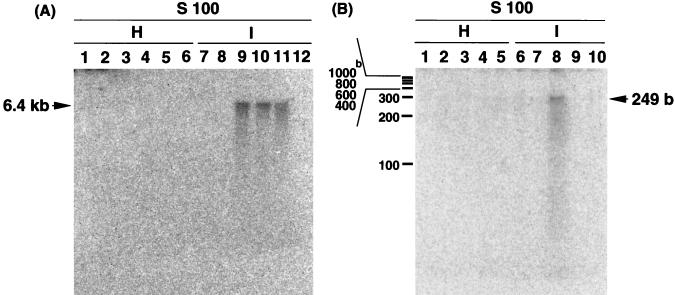FIG. 4.
Template activity of various RNAs in RNA synthesis in vitro by TMV RNA polymerase. (A) Template activity was tested for viral RNA from CMV strain Y (lanes 1 and 7), CMV RNA segment 3 (lanes 2 and 8), transcript of the full-length cDNA of TMV strain OM added with the 5′-cap structure (lanes 3 and 9), the same RNA without the 5′-cap structure (lanes 4 and 10), and viral RNA from TMV strain OM (lanes 5 and 11). Lanes 6 and 12, no added template. The 5′-cap structure of the transcript of TMV cDNA was added by using the vaccinia virus capping enzyme. To 0.06 pmol each of these templates, the immunoaffinity-purified RNA polymerase from healthy (H, lanes 1 to 6) or virus-infected (I, lanes 7 to 12) was added as described in Fig. 3. In vitro transcription assay was carried out under the standard conditions with [α-32P]UTP as a labeled substrate. RNA products were analyzed by urea–4% PAGE, and the gel was visualized with a BAS-2000 image analyzer (Fuji). The migration position of full-length TMV RNA is shown on the right. (B) Template activity was tested for the 53-base model mini-vRNA for influenza virus RNA polymerase (lanes 1 and 6); 64 base mRNA2 used in the analysis of influenza virus RNA polymerase (lanes 2 and 7); the 249-base model mini-vRNA for TMV RNA polymerase (lanes 3 and 8); 807-base TMV RNA, including the 30K protein coding sequence (lanes 4 and 9); and no RNA control (lanes 5 and 10). All of these RNAs were prepared by transcribing the respective template DNAs with T7 RNA polymerase. In vitro transcription assay was carried out by using 0.5 pmol each of these templates and under the standard reaction conditions as above. RNA products were analyzed by urea–8% PAGE.

